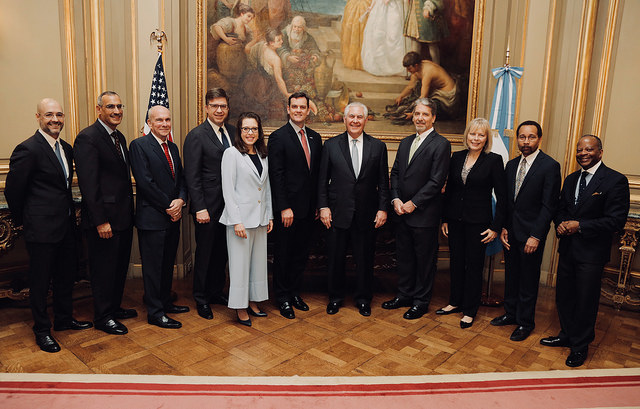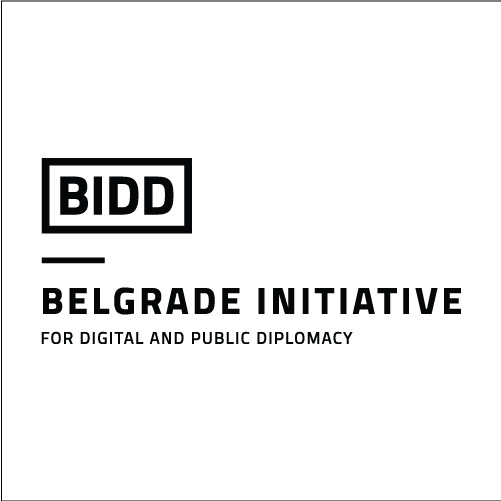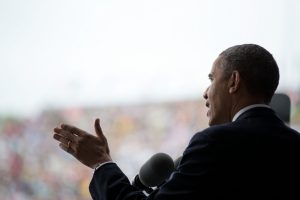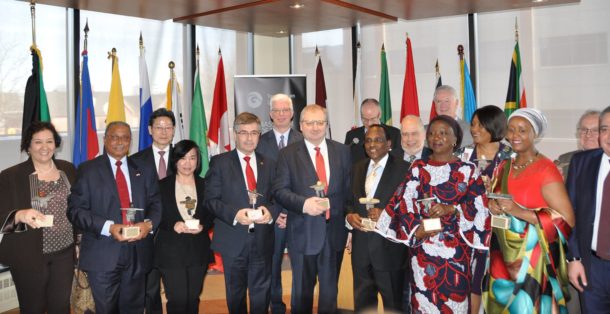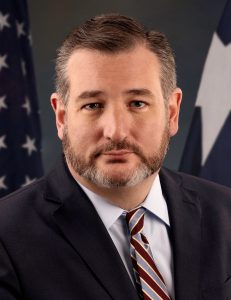Ryan Scoville, lawfareblog.com; for Tables 1 & 2, mentioned in the text below, and which for technical reasons cannot be reproduced in full on this blog, please consult original article. Then-Secretary of State Rex Tillerson meets with U.S. ambassadors and chargé d'affaires for South America, February 2018 (Source: Flickr/State Department)Since the 1950s, presidents have consistently allocated roughly 30 percent of ambassadorial appointments to individuals who are not career diplomats. This practice, atypical among advanced democracies and a recurrent source of controversy, is currently on track to expand: Over the first two years of the Trump administration, more than 40 percent of appointments to bilateral ambassadorships went to presidential supporters who are not foreign service officers. For example, Robert Wood Johnson IV—the ambassador to the United Kingdom—co-owns the New York Jets. Carla Sands (Denmark) is a chiropractor and former actress. David Friedman (Israel) is a bankruptcy lawyer.These individuals are commendable for their professional success and interest in public service, but their appointments raise important questions: Are political appointees less effective in office? How do their backgrounds compare to those of career ambassadors under accepted metrics of competency, such as experience in organizational leadership and basic familiarity with the language [JB see below regarding the use of the local language in the practice of public diplomacy (JB emphasis) abroad] and government of the receiving state? What is the role of money in the selection process? Do any tendencies emerge with respect to specific bilateral relationships? And have any patterns evolved across recent administrations?Evidence to answer these questions has been in short supply. With a few noteworthy exceptions, commentators have not attempted to collect information in any sort of systematic way. Instead, they have relied heavily on anecdote and impression to critique or defend political appointments.This is unfortunate. Without anything close to complete information, stakeholders cannot fully understand the modern practice and may leave significant trends unappreciated and unaddressed. Likewise, without much evidence, it is difficult for the public to hold the president and senators accountable, and difficult for commentators to make a compelling case for or against any particular type of nominee. In the end, the quality of U.S. diplomatic representation may suffer, with attendant harm to U.S. foreign relations.But it doesn’t have to be this way. Section 304 of the Foreign Service Act of 1980 requires the Congressional Record to publish a report on each ambassadorial nominee’s financial contributions to the nominating president and associated or supporting entities, including political parties and independent expenditure groups. The statute also requires the president to provide the Senate Committee on Foreign Relations with a “report on the demonstrated competence of [each] nominee to perform the duties of the position in which he or she is to serve.” Commonly known as “certificates of demonstrated competency,” these reports contain information on whether a nominee possesses “a useful knowledge of the principal language or dialect of the [receiving] country” and “knowledge and understanding of the history, the culture, the economic and political institutions, and the interests of that country and its people.” Collecting these documents would make it possible to analyze decades of information on the financial contributions and professional credentials of individual nominees.So that’s what I did. To identify trends in campaign contributions, I gathered nearly 40 years of financial reports from the Congressional Record, adjusted values for inflation and tallied the results. I also collected the certificates of demonstrated competency and coded their contents, but doing so required more work: In April 2014, the Obama administration announced a policy to disclose the certificates for all future nominees, and in December 2016, Congress converted that policy into a statutory mandate.These developments have fostered transparency with respect to dozens of recent nominations, but they also have left unavailable the certificates for all nominees from 1980 to the date of the Obama administration’s announcement—so I filed a request under the Freedom of Information Act (FOIA) to obtain the remaining 30-plus years of certificates. The State Department granted this request and, over the next two and a half years, delivered certificates for approximately 1,000 bilateral nominations. This amounted to barely more than half of the extant records, however, so I filed a lawsuit in May 2017 to compel an adequate search for the remainder. To settle the case, the department delivered certificates for an additional 600 nominations in the ensuing months. This brought the total to roughly 1,600, which amounts to nearly all bilateral nominations from 1980 to 2014. After collecting these documents, I combined them with the records the State Department has posted online since 2014 and then coded and analyzed their contents.Two findings carry overarching significance: First, since 1980, the average political nominee has been materially less qualified than the average career nominee under a number of standard measures, including language ability, knowledge of the receiving state and its region, and experience in U.S. foreign policy and organizational leadership.Take, for instance, the issue of language. The certificates suggest that while 66 percent of career nominees possessed a degree of prior aptitude in the receiving state’s principal language, the same was true of only 56 percent of political nominees, as shown in Figure 1. Upon excluding ambassadorships to English-speaking states, the gap was even larger (56 percent versus 28 percent). In short, a sizable portion of nominees have been completely unable to communicate in the most relevant foreign tongue—and this is particularly true of those who come from outside the foreign service.Figure 1: Prior Knowledge of Principal Languages Since 1980
Then-Secretary of State Rex Tillerson meets with U.S. ambassadors and chargé d'affaires for South America, February 2018 (Source: Flickr/State Department)Since the 1950s, presidents have consistently allocated roughly 30 percent of ambassadorial appointments to individuals who are not career diplomats. This practice, atypical among advanced democracies and a recurrent source of controversy, is currently on track to expand: Over the first two years of the Trump administration, more than 40 percent of appointments to bilateral ambassadorships went to presidential supporters who are not foreign service officers. For example, Robert Wood Johnson IV—the ambassador to the United Kingdom—co-owns the New York Jets. Carla Sands (Denmark) is a chiropractor and former actress. David Friedman (Israel) is a bankruptcy lawyer.These individuals are commendable for their professional success and interest in public service, but their appointments raise important questions: Are political appointees less effective in office? How do their backgrounds compare to those of career ambassadors under accepted metrics of competency, such as experience in organizational leadership and basic familiarity with the language [JB see below regarding the use of the local language in the practice of public diplomacy (JB emphasis) abroad] and government of the receiving state? What is the role of money in the selection process? Do any tendencies emerge with respect to specific bilateral relationships? And have any patterns evolved across recent administrations?Evidence to answer these questions has been in short supply. With a few noteworthy exceptions, commentators have not attempted to collect information in any sort of systematic way. Instead, they have relied heavily on anecdote and impression to critique or defend political appointments.This is unfortunate. Without anything close to complete information, stakeholders cannot fully understand the modern practice and may leave significant trends unappreciated and unaddressed. Likewise, without much evidence, it is difficult for the public to hold the president and senators accountable, and difficult for commentators to make a compelling case for or against any particular type of nominee. In the end, the quality of U.S. diplomatic representation may suffer, with attendant harm to U.S. foreign relations.But it doesn’t have to be this way. Section 304 of the Foreign Service Act of 1980 requires the Congressional Record to publish a report on each ambassadorial nominee’s financial contributions to the nominating president and associated or supporting entities, including political parties and independent expenditure groups. The statute also requires the president to provide the Senate Committee on Foreign Relations with a “report on the demonstrated competence of [each] nominee to perform the duties of the position in which he or she is to serve.” Commonly known as “certificates of demonstrated competency,” these reports contain information on whether a nominee possesses “a useful knowledge of the principal language or dialect of the [receiving] country” and “knowledge and understanding of the history, the culture, the economic and political institutions, and the interests of that country and its people.” Collecting these documents would make it possible to analyze decades of information on the financial contributions and professional credentials of individual nominees.So that’s what I did. To identify trends in campaign contributions, I gathered nearly 40 years of financial reports from the Congressional Record, adjusted values for inflation and tallied the results. I also collected the certificates of demonstrated competency and coded their contents, but doing so required more work: In April 2014, the Obama administration announced a policy to disclose the certificates for all future nominees, and in December 2016, Congress converted that policy into a statutory mandate.These developments have fostered transparency with respect to dozens of recent nominations, but they also have left unavailable the certificates for all nominees from 1980 to the date of the Obama administration’s announcement—so I filed a request under the Freedom of Information Act (FOIA) to obtain the remaining 30-plus years of certificates. The State Department granted this request and, over the next two and a half years, delivered certificates for approximately 1,000 bilateral nominations. This amounted to barely more than half of the extant records, however, so I filed a lawsuit in May 2017 to compel an adequate search for the remainder. To settle the case, the department delivered certificates for an additional 600 nominations in the ensuing months. This brought the total to roughly 1,600, which amounts to nearly all bilateral nominations from 1980 to 2014. After collecting these documents, I combined them with the records the State Department has posted online since 2014 and then coded and analyzed their contents.Two findings carry overarching significance: First, since 1980, the average political nominee has been materially less qualified than the average career nominee under a number of standard measures, including language ability, knowledge of the receiving state and its region, and experience in U.S. foreign policy and organizational leadership.Take, for instance, the issue of language. The certificates suggest that while 66 percent of career nominees possessed a degree of prior aptitude in the receiving state’s principal language, the same was true of only 56 percent of political nominees, as shown in Figure 1. Upon excluding ambassadorships to English-speaking states, the gap was even larger (56 percent versus 28 percent). In short, a sizable portion of nominees have been completely unable to communicate in the most relevant foreign tongue—and this is particularly true of those who come from outside the foreign service.Figure 1: Prior Knowledge of Principal Languages Since 1980 One might fairly question the significance of this finding. With indications that English replaced French as the primary language of diplomacy decades ago, there is reason to believe that foreign officials will often speak English even when it is not a common or official language among their compatriots. But the the presence of English-conversant foreign elites is unlikely to dissolve the value of foreign language skills, which not only guarantee an ability to communicate with a broader range of foreign counterparts but also facilitate public diplomacy [JB emphasis] and serve as indicia of respect for the people and culture of the receiving state. In this regard, the data suggest that political appointees have been less effective than career ambassadors at certain official functions.Note, moreover, that language deficiencies tend to affect some receiving states much more than others. As indicated in Figure 2, pre-existing language ability has been typical among ambassadors to states in Africa, Central and South America, and Oceania, but uncommon among ambassadors to states in Europe, the Middle East, and East and Southeast Asia. Given the many challenges that confront U.S. policymakers, one could argue that there’s little room for deficiencies of any kind in U.S. representation to states in any of these regions.Figure 2: Prior Knowledge of Principal Languages Since 1980
One might fairly question the significance of this finding. With indications that English replaced French as the primary language of diplomacy decades ago, there is reason to believe that foreign officials will often speak English even when it is not a common or official language among their compatriots. But the the presence of English-conversant foreign elites is unlikely to dissolve the value of foreign language skills, which not only guarantee an ability to communicate with a broader range of foreign counterparts but also facilitate public diplomacy [JB emphasis] and serve as indicia of respect for the people and culture of the receiving state. In this regard, the data suggest that political appointees have been less effective than career ambassadors at certain official functions.Note, moreover, that language deficiencies tend to affect some receiving states much more than others. As indicated in Figure 2, pre-existing language ability has been typical among ambassadors to states in Africa, Central and South America, and Oceania, but uncommon among ambassadors to states in Europe, the Middle East, and East and Southeast Asia. Given the many challenges that confront U.S. policymakers, one could argue that there’s little room for deficiencies of any kind in U.S. representation to states in any of these regions.Figure 2: Prior Knowledge of Principal Languages Since 1980 A shown in Table 1, a discrepancy between the qualifications of career and political nominees also manifests with respect to other congressionally approved measures, including experience in the receiving state and region. In this sense, and even if credentials only loosely predict performance in office, political nominees appear to be multidimensionally inferior to career nominees as a group.The second major finding is that things appear to be getting worse. Alongside a dramatic rise in the average size of financial contributions among political nominees in recent decades, the qualifications of the typical donor-nominee have fallen under a number of accepted measures.Consider some of the financial data: The Congressional Record shows that political nominees have contributed to the nominating president far more than career nominees in terms of both frequency and value. Since 1980, 73 percent of political nominees contributed funds, compared to only 5 percent of career nominees. Meanwhile the average contribution among political nominees was $84,850, compared to only $33 among their career counterparts. And the role of money has only grown. As shown in Figure 3, the average, inflation-adjusted value of contributions from political nominees rose from $12,916 under President Reagan to $189,448 under President Trump. These numbers, moreover, do not include bundling values, which likely increased in similar fashion over the same period. For whatever reason, financial contributions appear to have played a particularly significant role in political appointments during the administrations of Bush II and Trump, and contributions were far more common among career nominees under Obama than they were among career nominees under any other president.Figure 3: Nominee Contributions Since 1980
A shown in Table 1, a discrepancy between the qualifications of career and political nominees also manifests with respect to other congressionally approved measures, including experience in the receiving state and region. In this sense, and even if credentials only loosely predict performance in office, political nominees appear to be multidimensionally inferior to career nominees as a group.The second major finding is that things appear to be getting worse. Alongside a dramatic rise in the average size of financial contributions among political nominees in recent decades, the qualifications of the typical donor-nominee have fallen under a number of accepted measures.Consider some of the financial data: The Congressional Record shows that political nominees have contributed to the nominating president far more than career nominees in terms of both frequency and value. Since 1980, 73 percent of political nominees contributed funds, compared to only 5 percent of career nominees. Meanwhile the average contribution among political nominees was $84,850, compared to only $33 among their career counterparts. And the role of money has only grown. As shown in Figure 3, the average, inflation-adjusted value of contributions from political nominees rose from $12,916 under President Reagan to $189,448 under President Trump. These numbers, moreover, do not include bundling values, which likely increased in similar fashion over the same period. For whatever reason, financial contributions appear to have played a particularly significant role in political appointments during the administrations of Bush II and Trump, and contributions were far more common among career nominees under Obama than they were among career nominees under any other president.Figure 3: Nominee Contributions Since 1980 What happened to language abilities over this same period? They fell. As indicated in Figure 4, there was a consistent equality of aptitude under the Reagan, Bush I, and Clinton administrations, when at least 60 percent of each type of nominee possessed prior knowledge of the receiving state’s principal language. Yet under Bush II, Obama and Trump the numbers dropped to 42 percent, 47 percent and 52 percent, respectively.Figure 4: Prior Knowledge of Principal Languages by Administration
What happened to language abilities over this same period? They fell. As indicated in Figure 4, there was a consistent equality of aptitude under the Reagan, Bush I, and Clinton administrations, when at least 60 percent of each type of nominee possessed prior knowledge of the receiving state’s principal language. Yet under Bush II, Obama and Trump the numbers dropped to 42 percent, 47 percent and 52 percent, respectively.Figure 4: Prior Knowledge of Principal Languages by Administration The decline in language ability, moreover, is not unique. As shown in Table 2, political nominees under Trump have fared much worse than political nominees under Reagan in terms of not only language but also prior experience in the receiving state and region, foreign policy, and organizational leadership. But this is not simply a Trump problem—similar discrepancies also appear in comparing the political nominees of earlier presidents such as Reagan and Bush I with those of Bush II and Obama.I have no direct evidence as to why any of this has happened. However, given the ballooning cost of presidential elections and significant growth in the average size of campaign contributions in recent decades, it strikes me as entirely plausible that presidents have started to pay less attention to professional competency and more attention to finances in selecting among prospective nominees. In short, and assuming again that credentials predict performance in office, the numbers provide reason to believe that the expanding cost of presidential elections may be indirectly degrading the quality of U.S. diplomatic representation overseas.What to do? As I discuss in a forthcoming paper, Congress might consider three basic types of reforms.First, the Senate and the Senate Committee on Foreign Relations could amend their rules, including by prohibiting or restricting advice and consent on certain types of political nominees. As an example, one draft rule from the 1970s would have precluded Senate confirmation for “non-career ambassadorial nominees when the number of such nominees exceeds 15 percent of the total number of U.S. ambassadors accredited to foreign nations.” A different rule might bar or limit advice and consent on nominees who donated to the nominating president in excess of a specified amount and lack prior experience in foreign policy. Such restrictions would have a clear foundation in Article I, Section 5 of the Constitution, which gives the Senate power to “determine rules of its proceedings”—and would avoid tough questions under the Appointments Clause by formally preserving the president’s discretion to nominate and leaving the House of Representatives out of a process that the text of Article II seems to assign exclusively to the president and the Senate.Second, Congress could attempt to impose qualifications requirements by statute. A traditional view maintains that the narrow power to mandate qualifications for officeholders presupposes the broader power to create the underlying office. In the present context, that raises the question of whether Congress holds the power to create ambassadorships. There are reasonable arguments both ways on this issue, both textually and as a matter of historical practice. I explain these arguments at length in the paper, but for present purposes, briefly consider some of the key points on historical practice:On the one hand, the dominant if somewhat curious and underappreciated view and practice from the Founding to the late 19th century held that while the Constitution creates some offices, such as president, and while statutes create a variety of others, such as solicitor general, neither creates diplomatic offices. Instead, that task falls to the law of nations—a historical body of legal authority that loosely corresponds with contemporary international law. In the 1854 case of Goodrich v. Guthrie, for example, the Supreme Court explained that “[a]ll offices under the government of the United States are created, either by the law of nations, such as ambassadors and other public ministers, or by the constitution and statutes.” The result of this view would be that statutory qualifications requirements are unconstitutional—Congress cannot prescribe qualifications for ambassadors because it does not create the office of ambassador.On the other hand, the law-of-nations view largely disappeared from official sources by the early 20th century. And just as this happened, Congress began to enact—and successive presidents began to sign into law—a significant number of statutes that created ambassadorships. A statute from 1909, for instance, stated that “no new ambassadorships shall be created unless the same shall be provided for by Act of Congress.” Congress later provided for ambassadorships to countries such as Spain, Argentina, Chile and Poland, and more recently has enacted statutes creating offices such as Ambassador at Large for International Religious Freedom and Ambassador at Large to Combat Trafficking in Persons, among others. Given recent Supreme Court precedent that accords significant weight to such practice in adjudicating the separation of powers, Congress seems to have a colorable claim of authority to create the office of ambassador and, in turn, to regulate qualifications. Whether that claim is ultimately persuasive will depend on the relative weight that an interpreter chooses to accord to original meaning and modern practice.Finally, Congress could enact statutory measures to further enhance the transparency of the appointments process, including by simplifying financial reports, mandating information on a broader set of qualifications and requiring the administration of periodic performance surveys to embassy personnel, followed by the disclosure of survey results. These measures might help discourage the nomination of relatively unqualified donors—and, in doing so, bolster the effectiveness of U.S. representation in an era of seemingly waning American influence.Topics:
The decline in language ability, moreover, is not unique. As shown in Table 2, political nominees under Trump have fared much worse than political nominees under Reagan in terms of not only language but also prior experience in the receiving state and region, foreign policy, and organizational leadership. But this is not simply a Trump problem—similar discrepancies also appear in comparing the political nominees of earlier presidents such as Reagan and Bush I with those of Bush II and Obama.I have no direct evidence as to why any of this has happened. However, given the ballooning cost of presidential elections and significant growth in the average size of campaign contributions in recent decades, it strikes me as entirely plausible that presidents have started to pay less attention to professional competency and more attention to finances in selecting among prospective nominees. In short, and assuming again that credentials predict performance in office, the numbers provide reason to believe that the expanding cost of presidential elections may be indirectly degrading the quality of U.S. diplomatic representation overseas.What to do? As I discuss in a forthcoming paper, Congress might consider three basic types of reforms.First, the Senate and the Senate Committee on Foreign Relations could amend their rules, including by prohibiting or restricting advice and consent on certain types of political nominees. As an example, one draft rule from the 1970s would have precluded Senate confirmation for “non-career ambassadorial nominees when the number of such nominees exceeds 15 percent of the total number of U.S. ambassadors accredited to foreign nations.” A different rule might bar or limit advice and consent on nominees who donated to the nominating president in excess of a specified amount and lack prior experience in foreign policy. Such restrictions would have a clear foundation in Article I, Section 5 of the Constitution, which gives the Senate power to “determine rules of its proceedings”—and would avoid tough questions under the Appointments Clause by formally preserving the president’s discretion to nominate and leaving the House of Representatives out of a process that the text of Article II seems to assign exclusively to the president and the Senate.Second, Congress could attempt to impose qualifications requirements by statute. A traditional view maintains that the narrow power to mandate qualifications for officeholders presupposes the broader power to create the underlying office. In the present context, that raises the question of whether Congress holds the power to create ambassadorships. There are reasonable arguments both ways on this issue, both textually and as a matter of historical practice. I explain these arguments at length in the paper, but for present purposes, briefly consider some of the key points on historical practice:On the one hand, the dominant if somewhat curious and underappreciated view and practice from the Founding to the late 19th century held that while the Constitution creates some offices, such as president, and while statutes create a variety of others, such as solicitor general, neither creates diplomatic offices. Instead, that task falls to the law of nations—a historical body of legal authority that loosely corresponds with contemporary international law. In the 1854 case of Goodrich v. Guthrie, for example, the Supreme Court explained that “[a]ll offices under the government of the United States are created, either by the law of nations, such as ambassadors and other public ministers, or by the constitution and statutes.” The result of this view would be that statutory qualifications requirements are unconstitutional—Congress cannot prescribe qualifications for ambassadors because it does not create the office of ambassador.On the other hand, the law-of-nations view largely disappeared from official sources by the early 20th century. And just as this happened, Congress began to enact—and successive presidents began to sign into law—a significant number of statutes that created ambassadorships. A statute from 1909, for instance, stated that “no new ambassadorships shall be created unless the same shall be provided for by Act of Congress.” Congress later provided for ambassadorships to countries such as Spain, Argentina, Chile and Poland, and more recently has enacted statutes creating offices such as Ambassador at Large for International Religious Freedom and Ambassador at Large to Combat Trafficking in Persons, among others. Given recent Supreme Court precedent that accords significant weight to such practice in adjudicating the separation of powers, Congress seems to have a colorable claim of authority to create the office of ambassador and, in turn, to regulate qualifications. Whether that claim is ultimately persuasive will depend on the relative weight that an interpreter chooses to accord to original meaning and modern practice.Finally, Congress could enact statutory measures to further enhance the transparency of the appointments process, including by simplifying financial reports, mandating information on a broader set of qualifications and requiring the administration of periodic performance surveys to embassy personnel, followed by the disclosure of survey results. These measures might help discourage the nomination of relatively unqualified donors—and, in doing so, bolster the effectiveness of U.S. representation in an era of seemingly waning American influence.Topics:
 Ryan Scoville is an associate professor at Marquette University Law School and a managing editor for AJIL Unbound, the online companion to the American Journal of International Law. In 2018, he was a Fulbright Scholar at Sophia University in Tokyo.
Ryan Scoville is an associate professor at Marquette University Law School and a managing editor for AJIL Unbound, the online companion to the American Journal of International Law. In 2018, he was a Fulbright Scholar at Sophia University in Tokyo.


